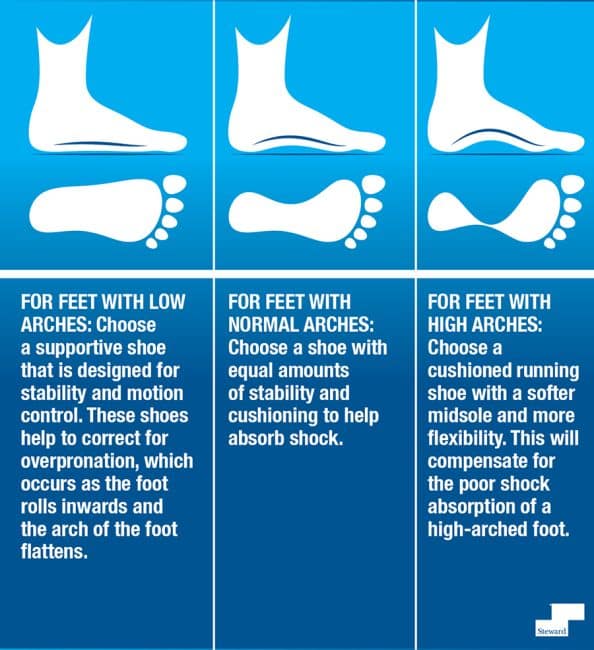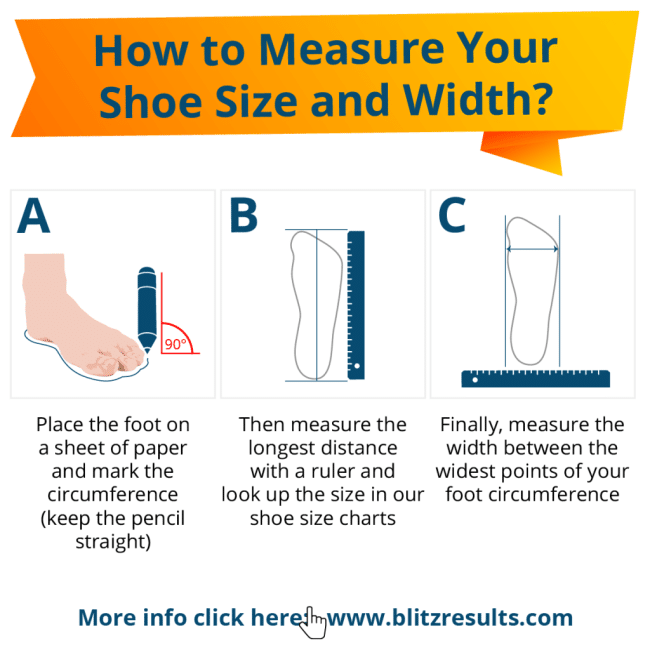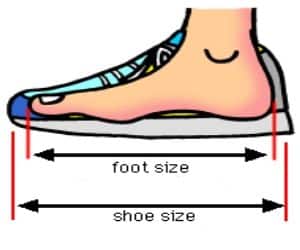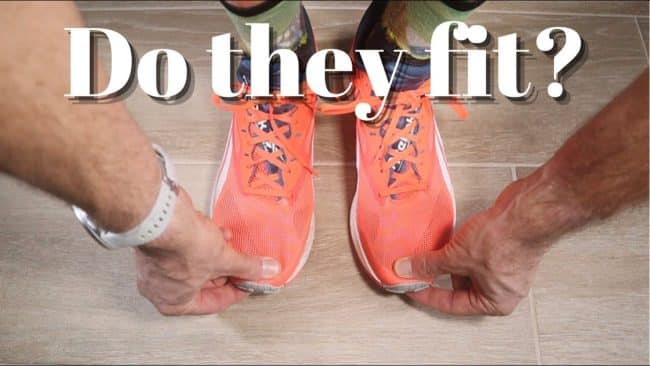Are you tired of uncomfortable running shoes that leave your feet aching after a workout? Well, we’ve got you covered! In this article, we’re going to share some simple yet effective tips on how to pick the right size running shoes. From measuring your feet to understanding the importance of a proper fit, we’ll guide you through the process of finding the perfect pair of running shoes that will keep you comfortable and injury-free. So, say goodbye to blisters and sore feet, and get ready to hit the pavement with confidence!
This image is property of www.stewardtoday.com.
Review contents
Understanding Foot Anatomy
Knowing your arch type
Understanding your arch type is crucial in choosing the right running shoes. The three main types of arches are:
-
High arches: If you have high arches, you may need extra cushioning to compensate for the lack of natural shock absorption. Look for shoes with ample arch support and cushioning to provide stability and prevent injury.
-
Normal arches: Considered the ideal arch type, individuals with normal arches have a balanced foot structure. Look for shoes that offer a good combination of support and flexibility.
-
Flat arches: People with flat arches tend to overpronate, meaning their feet roll inward when they walk or run. Look for shoes with motion control and stability features to prevent excessive rolling and provide much-needed support.
By understanding your arch type, you can select running shoes that address your specific needs and promote optimal comfort and performance.
Determining your foot width
Foot width is another important aspect when choosing running shoes. Here are a few indicators to help you determine your foot width:
-
Narrow feet: If you often find shoes feeling roomy or loose around the sides, you likely have narrow feet. Look for shoes labeled as narrow or slim to ensure a proper fit.
-
Medium/average feet: Most individuals fall into the medium or average foot width category. Shoes labeled as standard or medium will usually fit well.
-
Wide feet: If you frequently experience discomfort due to shoes feeling tight or cramped, you may have wide feet. Look for shoes labeled as wide or extra-wide for a more comfortable fit.
Determining your foot width can help you find shoes that provide the necessary space and support for your feet, reducing the risk of blisters or discomfort during your runs.
Analyzing your gait
Understanding your gait, or the way you walk or run, is crucial in selecting the right running shoes. There are three main types of gaits to consider:
-
Neutral gait: Individuals with neutral gait have a balanced stride, where the foot lands evenly and rolls naturally from heel to toe. Look for shoes with a good balance of cushioning and support to enhance your natural gait.
-
Overpronation: Overpronators have a tendency for the foot to roll excessively inward. Look for shoes with stability features, such as reinforced arch support and firm midsoles, to help correct and control overpronation.
-
Supination: Supinators have a tendency for the foot to roll outward, placing extra pressure on the outer edge of the foot. Look for shoes with ample cushioning and flexibility to redistribute impact and provide stability.
By understanding your gait, you can choose shoes specifically designed to support and align your feet, reducing the risk of injury and maximizing your running experience.
Measuring Your Feet
Using a Brannock device
One of the most accurate ways to measure your feet is by using a Brannock device. Found in specialty shoe stores, a Brannock device measures both the length and width of your feet. Follow these steps to measure your feet using a Brannock device:
- Stand with your weight evenly distributed on both feet.
- Slide your feet snugly into the device’s foot rests, making sure the heel is pressed firmly against the back.
- Adjust the width measuring bar to match the widest part of your foot.
- Read the measurements on the device, noting both the length and width.
Using a Brannock device ensures precise measurements and helps you find the right size when purchasing running shoes.
Tracing your feet on a piece of paper
If you don’t have access to a Brannock device, tracing your feet on a piece of paper can provide a rough estimate of your foot size. Here’s how to do it:
- Place a blank sheet of paper on a hard and flat surface.
- Sit down and place one foot firmly on the paper, ensuring the weight is evenly distributed.
- With a pen or pencil held perpendicular to the paper, trace around your foot, keeping the pen in contact with the skin.
- Repeat the process for the other foot.
- Measure the length and width of the tracings using a ruler or measuring tape.
While tracing your feet on paper may not be as accurate as using a Brannock device, it can serve as a helpful guide when selecting running shoe sizes.
Utilizing a smartphone app
For a convenient and modern approach to measuring your feet, smartphone apps can provide accurate measurements without the need for additional tools. Simply download a foot measuring app, follow the instructions provided, and capture the necessary measurements using your phone’s camera.
Just remember to calibrate the app correctly and follow the instructions closely for the most accurate results. Smartphone apps can be a convenient alternative, especially if you don’t have access to a Brannock device or prefer a digital approach.
Considering Shoe Types
Road-running shoes
Road-running shoes are designed to provide cushioning, support, and durability for running on pavement or other hard surfaces. These shoes often feature ample cushioning and responsive midsole materials to absorb impact and maintain comfort over long distances. If you primarily run on roads, sidewalks, or treadmills, road-running shoes are an excellent choice.
Trail-running shoes
For runners who prefer off-road adventures, trail-running shoes are the way to go. These shoes are specifically designed to handle uneven terrain, rocks, and muddy conditions. With aggressive outsoles for exceptional traction, reinforced uppers to protect against debris, and additional stability features, trail-running shoes provide the necessary support and protection while conquering nature’s challenges.
Track and race shoes
Track and race shoes are built with speed in mind. These lightweight and sleek shoes offer minimal cushioning to reduce weight and increase responsiveness. They are often used for short-distance sprints or fast-paced competitions. If you’re a competitive runner or enjoy participating in races, track and race shoes can help you achieve your personal best time.
Minimalist shoes
Minimalist shoes, also known as barefoot shoes or minimalist running shoes, aim to mimic the feeling of running barefoot. They have minimal cushioning, a low heel-to-toe drop, and a flexible sole. Minimalist shoes encourage a more natural running style and foot strength building. However, they are not recommended for beginners or individuals with pre-existing foot conditions, as they require a gradual transition and may lack necessary support for certain individuals.
Consider your running terrain, goals, and preferences when selecting the right type of running shoes for your needs. Remember, different shoe types provide distinct features and benefits, so choose accordingly to optimize your running experience.
Factoring in Toe Box Space
Seeking adequate wiggle room
Having sufficient toe box space is crucial for comfort and avoiding issues such as blisters, ingrown toenails, or cramped toes. When trying on running shoes or assessing their toe box space, make sure there is enough room for your toes to wiggle freely, particularly during toe-off phase.
Avoiding cramped toe boxes
On the other hand, it’s important to avoid shoes with excessively roomy toe boxes. If your toes slide forward and hit the front of the shoe when running downhill or during sharp turns, it can lead to discomfort and potential toenail problems. Look for shoes that strike a balance between providing adequate space and preventing your toes from moving excessively within the shoe.
Considering special needs (bunions, hammertoes)
Individuals with bunions or hammertoes may require additional considerations when choosing running shoes. Look for shoes with a wide toe box and stretchable or soft upper materials to accommodate these deformities. Avoid shoes with narrow or rigid toe boxes that can further aggravate these conditions.
By factoring in toe box space, you can ensure a comfortable and secure fit, reducing the risk of foot-related issues during your runs.
This image is property of i.ytimg.com.
Evaluating Heel Fit
Ensuring secure fit with minimum slippage
A proper heel fit is essential for stability and efficient energy transfer while running. Here’s how to evaluate the heel fit of running shoes:
- Lace up the shoes tightly to secure the foot in place.
- Stand up and walk around the store, paying attention to any slipping or excessive movement of the heel.
- Bend and flex your knees, mimicking the motion of running, to test the shoe’s stability.
Ideally, the shoes should provide a secure fit with minimal slippage in the heel area. If you experience significant heel slippage, it can lead to discomfort, blisters, or even ankle rolling.
Avoiding pressure points or rubbing
When evaluating heel fit, be mindful of any pressure points or areas of rubbing. Shoes that rub against the Achilles tendon or cause discomfort can lead to blisters or abrasions. Look for shoes with padded heel collars or Achilles cushions to enhance comfort and reduce friction.
Checking for heel lift
Heel lift refers to the upward movement of the heel within the shoe during the running motion. Excessive heel lift can indicate a poor fit or inadequate support. When trying on running shoes, pay attention to any noticeable heel lift and choose a pair that minimizes this movement.
By ensuring a proper heel fit, you can enhance stability, minimize discomfort, and improve overall performance during your runs.
Assessing Overall Length and Width
Selecting proper length
Selecting the proper length of running shoes is crucial for optimal comfort and performance. Here are some guidelines to help you find the right length:
-
Toe clearance: There should be approximately a half-inch (about the width of your thumb) of space between your longest toe (usually the big toe) and the front of the shoe. This allows for natural toe splay and helps prevent toenail injuries.
-
No cramping: Ensure there is no cramping or pressure on the sides of your feet. If the shoes feel excessively tight or squeeze the sides of your feet, it may be a sign that they are too narrow.
It’s important to note that shoe sizes may vary between brands, models, and even individual styles. Trying on multiple sizes and taking into account your specific foot shape will help you determine the proper length of running shoes.
Determining suitable width
In addition to the length, determining the suitable width of running shoes is equally important for comfort. Consider the following factors when assessing the width:
-
Even pressure distribution: The shoes should distribute pressure evenly across the width of your foot. If you feel excessive pressure on specific areas, it may be an indication that the width is too narrow.
-
No slippage: While the shoes should not be overly wide, they should also not feel loose or allow for excessive movement. A snug fit that provides stability without pinching is ideal.
Taking into account your foot width and ensuring proper width in running shoes will prevent discomfort, blisters, or other foot-related issues during your runs.
This image is property of talkultra.files.wordpress.com.
Understanding Sizing Discrepancies
Varying sizing standards
Sizing standards can vary between different shoe brands and even within the same brand. A size 9 from one brand may fit differently than a size 9 from another brand. This discrepancy can be due to variations in manufacturing processes, design, or target markets. It’s important to try on shoes and not solely rely on the numerical size to ensure the best fit.
Factoring in half sizes and widths
When choosing running shoes, consider if the brand offers half sizes or varying widths. These options can be especially beneficial if you find yourself between sizes or have narrow or wide feet. Half sizes or different width options allow for a more precise fit and can improve comfort during your runs.
Considering international shoe sizes
If you’re purchasing running shoes internationally or from a brand based in another country, it’s essential to consider international shoe sizing standards. Different countries may use different sizing systems, such as UK, European, or US sizes. Familiarize yourself with the specific conversions or consult size charts provided by the shoe manufacturer to ensure an accurate fit.
By understanding sizing discrepancies and taking them into account, you can avoid potential fit issues and select running shoes that provide the best possible fit and comfort.
Trying on Multiple Pairs
Experimenting with different brands
When it comes to running shoes, trying on multiple pairs from different brands can help you find the perfect fit. Each brand has its own design philosophy, manufacturing processes, and fit characteristics. By trying on various brands, you can assess which ones feel the most comfortable and supportive for your feet.
Testing various styles and models
Within a brand, there are often multiple styles and models of running shoes to choose from. These variations offer different features, cushioning levels, and support systems. It’s beneficial to test different styles and models to find the one that suits your specific running needs and preferences. Don’t be afraid to ask for recommendations from experts or fellow runners to narrow down your options.
By trying on multiple pairs of running shoes and testing different brands, styles, and models, you increase your chances of finding the perfect fit that supports your feet and enhances your running experience.
This image is property of content.instructables.com.
Wearing the Right Socks
Opting for moisture-wicking materials
Choosing the right socks is an often overlooked aspect of finding the perfect running shoe fit. Opt for socks made from moisture-wicking materials, such as synthetic blends or merino wool. These materials help wick away sweat and moisture from your feet, keeping them dry and reducing the risk of blisters or discomfort during your runs.
Avoiding thick or bulky socks for precise fit
While cushioned or thick socks might be appealing for extra comfort, they can affect the fit of your running shoes. Thick or bulky socks may take up valuable space in the shoe, potentially leading to a tighter fit or pressure points. Opt for socks with medium thickness and a snug fit to ensure a more precise fit and prevent unnecessary rubbing or blisters.
By wearing the right socks, you create a comfortable and conducive environment for your feet, allowing your running shoes to fit optimally and perform at their best.
Seeking Expert Assistance
Consulting a professional shoe fitter
If you’re unsure about the right running shoe size or need additional guidance, consider consulting a professional shoe fitter. These experts are trained to measure feet accurately, assess gait, and provide personalized recommendations based on your individual needs. They can help you navigate the sometimes confusing world of running shoe options and ensure you find the perfect fit.
Visiting specialty running stores
Specialty running stores are havens for runners seeking the right footwear. These stores typically have knowledgeable staff who can offer expert advice, assist with foot measurements, and help you select the most suitable running shoes. Take advantage of their expertise and make use of their fitting services to find the ideal running shoes for your unique needs.
By seeking expert assistance, you can receive professional guidance, accurate measurements, and personalized recommendations to ensure you find the perfect running shoes for your feet.
In conclusion, selecting the right size running shoes involves understanding foot anatomy, measuring your feet accurately, considering different shoe types, evaluating specific fit aspects like toe box space and heel fit, assessing overall length and width, understanding sizing discrepancies, trying on multiple pairs, wearing the right socks, and seeking expert assistance when needed. By following these guidelines and taking the time to find the perfect fit, you can enjoy comfortable and supportive running shoes that enhance your performance and minimize the risk of foot-related issues. So lace up, hit the road or trail, and enjoy your runs with confidence and comfort!
This image is property of i.ytimg.com.













